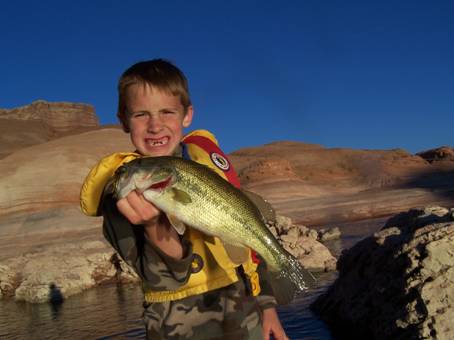|
|||
|
|
Powell Fish Await Warm Days; Water temperature at this writing was still in the low 50s. All the fish are poised for the early morning temperature to reach 57-60 F. When that happens, which may be soon, the fun begins. A few largemouth bass have spawned. Usually, the largest fish are the first to make beds in prime spots. The majority of the population will be moving shallow this weekend and next week, weather permitting. Even those that spawned previously will come back to the nest they abandoned and spawn again with the next warm spell. If a nest is found, cast slowly descending plastic baits (Senkos, flukes) right on to the nest ring and watch the male bass rush over to grab the lure and haul it away from the nest. Some just grab the tail and never get the hook in the mouth, but it is sure fun to watch them work. Return males caught on the nest so they can protect the young from predators. If no nests are seen in clear water, go to the back of the canyon where the green and brown water meet. This zone warms up sooner and provides bass and crappie a warm spot to live while waiting for real warming. Brush piles will hold largemouth and crappie, while smallmouth bass will be on rock ridges, terraces and points. Use your favorite technique in these conditions. The fish won’t care and will take all incoming lures and offerings. Stripers remain in the channel where they can be caught by the tubful with anchovy bait and copious chumming. There is not a lot of forage this time of year. Most of the stripers are small enough that they can eat plankton to maintain their body while waiting for a fish dinner. The plankton supply is most abundant in the upper 20 feet of the water column, so many stripers are in the upper zone. That makes them prime targets for shallow trolling lures as well as bait. I have effectively used Wally Divers, various rattletrap types, and bevy shad to consistently catch mature male stripers. The trick is to find them. My search pattern has consistently led to striper schools’ holding on the breaking edge of a long point. By long, I mean at least 100 yards or more. Follow the shallow point (5-12 feet) out until it breaks from 20-25 feet and goes quickly to a depth of 40 feet or more. Follow that 25-foot, sharp-breaking contour to find stripers holding right on the edge at 25 feet. When a school is located, troll back and forth over the spot or mark the school and hold with the trolling motor while chumming to keep them in place. This allows you to find your own private fishing spot and not have to share it with others in the popular (dam, Moki Wall) or well-known striper fishing spots. If it’s your first time, go fish with the anglers at the popular spots to see their techniques, get a few tips, and measure success. Note: At press time, lake elevation was 3,591, and water temperature was 53-65F. |
|
|
 May 2008
May 2008 Wayne Gustaveson
Wayne Gustaveson